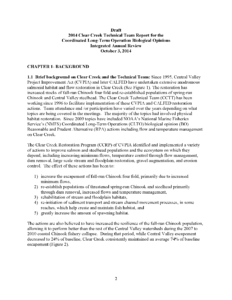Document Details
2014 Clear Creek Technical Team Report for the Coordinated Long-Term Operation Biological Opinions Integrated Annual Review October 3, 2014
Natural Resources Conservation Service (NRCS), National Marine Fisheries Service (NMFS), California Department of Fish and Wildlife (CDFW), U.S. Bureau of Reclamation (USBR), Western Shasta Resource Conservation District (WSRCD), U.S. Fish and Wildlife Service (USFWS), California Department of Water Resources (DWR), Graham Matthews and Associates (GM&A), Central Valley Regional Water Quality Control Board (Central Valley R-5) | October 3rd, 2014

Keywords
anadromous fish, Central Valley Project (CVP), ecosystem management, endangered species, fisheries, habitat restoration, native fish, Sacramento–San Joaquin Delta, State Water Project (SWP), water project operations, water quality